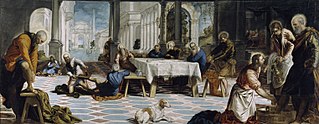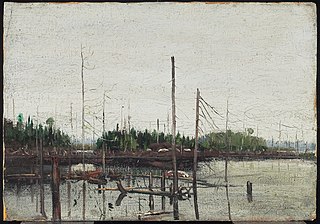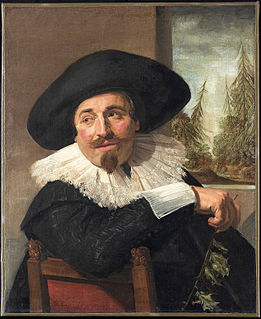 W
WThe Bust of Pope Gregory XV is a marble portrait sculpture by the Italian artist Gian Lorenzo Bernini. Executed in 1621, the work is one of three busts of the subject created by Bernini—the other two were bronze casts. The marble bust is on permanent display at the Art Gallery of Ontario. It was donated to the museum by Joey and Toby Tanenbaum.
 W
WCharing Cross Bridge is a series of oil paintings by French artist Claude Monet. The paintings depict a misty, impressionist Charing Cross Bridge in London, England. Monet worked on the series from 1899 to 1905, totaling 37 paintings of the bridge.
 W
WChrist Washing the Disciples' Feet was a favourite theme of Tintoretto, and there are at least six known works by him on the subject. The scene comes from a passage in John 13 where before the Last Supper Christ washes the feet of his disciples. This passage called for a complex image with many characters in a variety of poses and motions, and the diversity and challenge attracted Tintoretto. The paintings were commissioned for various churches of Venice, though since then four of the six have left Italy.
 W
WCorpus is a life-size bronze sculpture of the crucified Jesus by Gian Lorenzo Bernini. Cast in 1650, Bernini held onto it in his private collection for 25 years.
 W
WDrowned Land is a 1912 oil sketch by the 20th-century Canadian painter Tom Thomson.
 W
WThe Elevation of the Cross is the name of two paintings, a very large triptych in oil on panel and a much smaller oil on paper painting. Both pieces were painted by the Flemish artist Peter Paul Rubens in Antwerp, Belgium, the original in 1610 and the latter in 1638.
 W
WFine Weather, Georgian Bay is a 1913 oil painting by J.E.H. MacDonald. It is in the collection of the Art Gallery of Ontario located in Toronto, Ontario, Canada.
 W
WThe Harvest Wagon is the name of two oil paintings by the English artist Thomas Gainsborough. The first version was completed around 1767 and is today owned by the Barber Institute of Fine Arts, in Birmingham, England. The second version was painted around 1784 and is now part of the collection of the Art Gallery of Ontario. The Toronto version is the better known of the two. It was donated to the AGO by Frank P Wood in 1941, and is one of the most prominent pieces in the gallery’s collection.
 W
WI Am Half-Sick of Shadows, Said the Lady of Shalott is a painting by John William Waterhouse completed in 1915. It is the third painting by Waterhouse that depicts a scene from the Tennyson poem, "The Lady of Shalott". The title of the painting is a quotation from the last two lines in the fourth and final verse of the second part of Tennyson's poem:
 W
WThe Indian Church is a 1929 painting by Canadian artist Emily Carr. Group of Seven artist Lawren Harris bought the painting to showcase it in his dining room, and called it Carr's best work. In 1930, the work was shown in the Fifth Annual Exhibition of Canadian Art organised by the National Gallery of Canada. In 1938, the painting was chosen for an exhibition titled A Century of Canadian Art, at the Tate Gallery. The exhibition was described by Vincent Massey as "a most representative showing of Canadian painting and sculpture, including all schools and all periods." It is considered a "transitional" painting because it reflects the transition of Carr's artistic work from purely depicting Native Art to shifting her focus toward the land.
 W
WThe Marchesa Casati is a portrait of Luisa Casati by Augustus John, painted in oil on canvas in 1919. It is currently housed in the collection of the Art Gallery of Ontario (AGO) in Toronto.
 W
WThe Massacre of the Innocents is the subject of two paintings by Peter Paul Rubens depicting the episode of the biblical Massacre of the Innocents of Bethlehem, as related in the Gospel of Matthew (2:13-18). The first, measuring 142 x 182 cm, was painted after his return to his native Antwerp in 1608, following eight years spent in Italy.
 W
WPont Boieldieu in Rouen, Rainy Weather is an 1896 painting by Camille Pissarro in the collection of the Art Gallery of Ontario.
 W
WPortrait of a Seated Woman with a Handkerchief is a painting at the Art Gallery of Ontario. Today it is attributed to Carel Fabritius, but was previously considered a work by Rembrandt.
 W
WPortrait of Henry VIII is a lost work by Hans Holbein the Younger depicting Henry VIII. It was destroyed by fire in 1698, but is still well known through many copies. It is one of the most iconic images of Henry and is one of the most famous portraits of any British monarch. It was originally created in 1536–1537 as part of a mural showing the Tudor dynasty at the Palace of Whitehall, London.
 W
WPortrait of Isaak Abrahamsz. Massa is a 1626 painting by Frans Hals that is in the collection of the Art Gallery of Ontario. It depicts Isaac Massa, a prosperous merchant and a close friend of Hals. Massa was the subject of an earlier work by Hals – Isaak Abrahamsz Massa and Beatrix van der Lean – which also featured his wife. Massa would commission another portrait by Hals in 1635.
 W
WScene in the Northwest: Portrait of John Henry Lefroy, also known as The Surveyor, is a painting by Paul Kane circa 1845. It sold at auction in 2002 for C$5.1 million, making it the most expensive Canadian painting ever sold at that time. It was purchased by media magnate Ken Thomson, who donated it to the Art Gallery of Ontario. The painting depicts British explorer John Henry Lefroy on his successful expedition to map the Magnetic North Pole.
 W
WThe Shop Girl is a painting by James Tissot in the collection of the Art Gallery of Ontario. The painting depicts a young woman standing inside a shop selling ribbons and dresses. In one hand she holds a wrapped package of newly purchased items. With the other she holds open the door to the store for the viewer to depart. The shop is filled with piles of ribbons. Outside a busy Parisian street scene is visible through the shop windows. A well dressed man stares in through the window and is greeted by the other girl in the shop.
 W
WStretch #1 is a sculpture by Evan Penny in the collection of the Art Gallery of Ontario located in Toronto, Ontario, Canada.
 W
WThe West Wind is a 1917 painting by Canadian artist Tom Thomson. An iconic image, the pine at its centre has been described as growing "in the national ethos as our one and only tree in a country of trees". It was painted in the last year of Thomson's life and was one of his final works on canvas.
 W
WYoung Woman with a Lapdog is a c. 1665 painting of an unknown young woman by Rembrandt. It is now in the Art Gallery of Ontario, to which it was bequeathed in 1955 by the philanthropist Frank Peter Wood. It was previously identified as Rembrandt's daughter-in-law Magdalena van Loo (1641–1669), but the subject is now held to be unknown.